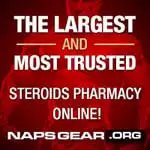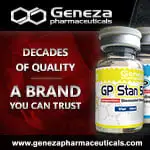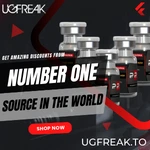I posted part of this in another thread and it got a good response. So I decided to make a seperate thread with a bit more info.
As you may know, I'm a real big fan of t'ren. With that being said, any responsible person is going to do some research concerning anything they put into their bodies. I still learn things regularly, but heres a bit of info I've saved. I am not the author, simply the narrator.
I know its long, but please bare with me . I promise, I'll make it worth your while
. I promise, I'll make it worth your while  .
.
F'ina Cough - What is it and why do some experience it, and some not?
The term prostaglandin comes from the word-Prostate. The first prostoglandins were first dicovered in semen about the mid 1930's and it was thought that prostaglandins were made from the prostate. Since this time, it has been dicovered that most prostaglandins are not even constructed in the prostate.
Prostaglandins are made by two different pathways(Cyclooxygenase and Lipoxygenase), and considering prostaglandins are a group of about 20 lipid cells, they have contrary function; responsible for stimulating as well as alleviating inflammation(Inflammation stimulation is the rapid metabolism of them expelled through the bronchials), regulate blood flow to particular organs, control ion transport across membranes, modulate synaptic transmission, induce sleep, mediate lipid release, and regulate metabolism is various tissue.
Prostaglandins are synthesized from arachidonate(Lipoxygenase which catalyze the dioxygenation of polyunsaturated fatty acids) in the cell membrane by the action of phospholipase A2. Cyclooxygenase and lipoxygenase pathways, compete with one another to form prostaglandins(as well as thromboxane or leukotriene-leukotriene being a bronchial stimulator),
In the cyclooxygenase pathway, the prostaglandins D, E and F plus thromboxane and prostacyclin are made. Thromboxanes are made in platelets and cause constriction of vascular smooth muscle and platelet aggregation
Leukotrienes are made in leukocytes and macrophages via the lipoxygenase pathway. They are potent constrictors of the bronchial airways. They are also important in inflammation and hypersensitivity reactions as they increase vascular permeability.
Being that prostaglandins from either pathway, are still fatty acids of a group, they mediate lipid release and controll tissue metabolization, so fat burning is a luxerry of either pathway of formation. It's the pathway from which they are constructed that dictates "Finaplix - trenbolone acetate - cough". As prostaglandins made from the Cyclooxygenase pathway dictate muscle constriction and platlet aggregation, and the Lipoxygenase pathway dictates bronchial constriction(the main form of expulsion)
T'ren, is there anything stronger and does it convert to estrogen?
Neumann F.
The activity spectrum of trenbolone acetate is similar to that of 19-nortestosterone or those anabolics that are derived from 19-nortestosterone. The compound has about three times stronger androgenic effect than testosterone propionate. Its index of dissociation between anabolic/androgenic activity is 2--3. This index is 3--10 for the other anabolic agents. As regards the virilizing potency, trenbolone acetate is also on the top of the list. It seems that androgenicity and degree of virilization run paralle. The antigonadotropic activity (inhibition of ovulation and testicular growth) of trenbolone acetate exceeds that of testosterone propionate by the factor 3. The compound is not estrogenic and seemingly not or only weakly progestationally active. In principle, the androgenic activity (symptoms of virilization) as well as the antigonadotropic effect (disturbances of the menstrual cycle in women, inhibition of spermiogenesis in men) of trenbolone acetate might be noted. This risk, however, can be excluded by mere calculation.
In rats, 0.1 mg/kg trenbolone acetate have an antigonadotropic effect. This corresponds to a daily dose of 5--7 mg in humans. By the same extrapolation, a daily human dose of 100 mg can be calculated for androgenic activity. Such factors of conversion are, of course, not precise because rats are much less sensitive to androgens and anabolics than humans. Thus, testosterone propionate is active only in daily doses of 10--20 mg. If in humans trenbolone acetate also has three times the activity of testosterone propionate, effects in man had to be counted with not less than a daily intake of 3--5 mg trenbolone acetate.
Does t'ren burn fat? If so, how?
While reading this article keep in mind that trenbolone (trenbolone finaplix) binds to the androgen receptor incredibly well.
There are many mechanisms behind the ability of androgens to reduce body fat. However, one key determinant of the amount of adipose tissue reduced is that particular androgen's ability to bind to the androgen receptors (AR).
I need to mention that most androgens interact with both AR and GR (Glucocorticoid Receptors). We'll touch on that later. For now, let me explain why it matters how well an androgen binds to the AR in terms of reducing adipose tissue. Most of you know that ARs are present in tissue such as muscle. This is one of the mechanisms behind their ability to induce muscular hypertrophy. Now what does this have to do with body fat? Simple, AR's are present in adipose tissue as well.
What does this mean? Well, it's been shown that the higher the density of ARs, the more that lipid uptake is inhibited. It's also been shown that androgens that bind avidly to the AR cause an increase or upregulation of AR in adipocytes. I think the greater the androgen binds to the AR, the more upregulation of AR in adipocytes occurs. This would lead to a significant reduction in subcutaneous adipose tissue.
Notice that I specifically mentioned subcutaneous adipose tissue (fat right beneath the skin) and not visceral adipose tissue (fat around the internal organs). Why did I bother to differentiate between the two? Simple. For the most part, we bodybuilders are concerned only with subcutaneous adipose tissue. Visceral fat doesn't have much of an effect on a person's appearance. For that reason, we're only concerning ourselves with subcutaneous adipose tissue.
Now, what other mechanisms of action can account for the effects seen with those steroids that bind tightly to the AR? Well, those that bind tightly to the AR will decrease LPL (Lipoprotein Lipase), which is an enzyme that causes lipid accumulation. They may also decrease Acetyl-CoA Carboxylase and Fatty Acid Synthetase.
Another interesting note is that androgens have been shown to increase adenyl cylclase as well. This is the enzyme which is responsible for the conversion of cytoplasmic ATP into cyclic AMP. Increasing its concentrations is a good thing, in other words.
WTF is up with all this extra strength?!! And WTF is up with all this aggression!?!
The mechanism by which trenbolone mediates skeletal muscle hypertrophy is diversified and not very well understood. On the one hand trenbolone is a very active agonist of the androgen receptor, as illustrated by its increasing strength and aggression at the level it does. While this is a large contributor there is evidence that it mediates muscle growth by another pathway entirely2,3, namely the increasing of satellite cell sensitivity to an increase in IGF-1 (Insulin-Like growth factor 1) and FGF (Fibroblast growth factor). This would result in a much, much greater nutrient uptake and protein synthesis and explain why trenbolone is so much more potent in building lean muscle than other non-aromatizing, AR-mediated steroids like drostanolone and mesterolone.
Will t'ren give me cancer?!?!
Trenbolone, a synthetic androgen is used as a growth promotant in animal husbandry. Because of its steroidal structure and properties it has been extensively evaluated in a series of in vitro and in vivo assays to assess its genotoxic and initiating properties. Both the parent molecule 17-beta-hydroxy-trenbolone and its metabolite 17-alpha-hydroxy-trenbolone, produced only in cattle, have been tested.
17-beta-hydroxy-trenbolone was not genotoxic in the Ames Salmonella/microsome assay, cytogenetics assays in human lymphocytes and CHO cells, a micronucleus assay in CHO cells, a DNA repair synthesis assay in HeLa cells, mammalian cell mutation assays with CHO and V79 cells, the mouse micronucleus assay, rat bone marrow or spermatogonial cytogenetics assays or in a test for initiators in the rat. In the mouse lymphoma cell mutation assay with L 5178Y TK+/- cells, equivocal responses were obtained, particularly at highly toxic concentrations.
With 17-alpha-hydroxy-trenbolone a weak positive response was obtained in the L5178Y Tk +/- assay, particularly at highly toxic concentrations. Negative results were obtained in the Ames Salmonella/microsome assay, the cytogenetics assays using both human lymphocytes in vitro and rat bone marrow in vivo, the DNA repair assay and in the CHO mammalian cell mutation assay. It was also negative in the in vivo test for initiators. From this extensive battery of data, and also taking into account published data on trenbolone, it is concluded that 17-alpha-hydroxytrenbolone and 17-beta-hydroxy-trenbolone are devoid of genotoxic activity and are not initiators of cancer.
Whats with this trenbolone gynecomastia?
The potential relationship between trenbolone, thyrotropin-releasing hormone (TRH) and prolactin. TRH stimulates the synthesis and release of thyrotropin (thyroid stimulating hormone) from the pituitary. Thyrotropin in turn stimulates the release of the thyroid hormones. A negative feedback loop exists whereby low levels of T4 stimulate the release of TRH (1).
It has been established that in humans TRH is also capable of stimulating the release of prolactin. In hypothyroid patients there is often an elevation of TRH and prolactin due to diminished levels of T4. Galactorrhea often presents as a symptom of hypothyroidism.
In sheep, administration of trenbolone acetate results in 45% decrease in thyroxine levels. This should exert a stimulatory effect on TRH. ( Interestingly, the same study shows that unlike in humans prolactin levels in the sheep remained unchanged. This is due to the fact that in sheep, unlike in humans, TRH and prolactin are secreted independently of each other (5).)
If it assumed that trenbolone acetate also lowers thyroxine levels in humans, the resulting rise in TRH would stimulate prolactin release, leading to galactorrhea and gynecomastia.
Due to the lack of human studies involving trenbolone, we are all forced to speculate, and try to extrapolate from animal studies.
Here are a few suggestions that may help with t'ren induced gynecomastia:
A dopamine agonist like dotinex will lower prolacting levels which are elevated while taking a progestin like trenbolone or nandrolone. This will alleviate prolactin symptoms like loss of libido, erectile disfunction. and prolonged hpta recovery.
However, stimulation of the progesterone receptors can also cause gynecomastia which will not be affected by dostinex.
That's what the Arimidex - anastrozole - is in there for (or letrozole)
Bromo at 2.5mg/ed (split up twice/day) can replace the dostinex.
____________________________________________________
Thats all I've got saved, for now, folks. But wait! Theres more!
Heres my own personal history and experiences with trenbolone.
In the last 3 years I've ran trenbolone 4 times. 3 with acetate and 1 with enanthate, which was my most recent cycle. All cycles had a base of T'est Ent'h, 500-750mg/wk. I topped out at 1g/wk but didn't like the sides compared to pros. Heres my cycle history including trenbolone:
T'est testosterone enanthate, 500mg/wk, 1-10wks
T'ren Acet, 75mg/eod, 1-6wks
T'est testosterone enanthate, 750mg/wk, 1-10wks
T'ren Acet, 100mg/eod, 1-8wks
Turanabol, 50mg/ed, 1-6wks
T'est testosterone enanthate, 750mg/wk, 1-10wks (peaked at 1g for a couple wks)
T'ren Acet, 100mg/eod, 1-10wks
Turanabol, 60mg/ed, 1-5wks
T'est testosterone enanthate, 600mg/wk, 1-10wks
T'ren testosterone enanthate, 300mg/wk, 1-10wks
Heres what I gather about acetate:
Its powerful! Holy hell its powerful! Mg per mg, trenbolone acetate is much stronger than all other forms on trenbolone. Due to its acetate ester I felt the effects by the end of the first week, and then started seeing the effects by the end of the second. The sides were a bit worse on the acetate (which i attribute to it being stronger mg per mg) as compared to the acetate. The EOD shots kinda suck. I shoot Mon Wed Fri without a prob. I suggest acetate to first-time users due to it being in and out of your system fairly quick.
Heres what I gather about enanthate:
So much smoother! I didn't feel, or see, the effects until week 4 (due to the enanthate ester). As I said before, the sides were half as apparent on the enanthate. My night sweats were much lighter, i slept a bit better, and i wasn't as emotionally effected. And to beat all, my gains were quite a bit better!!! I was quite a bit more vascular, much stronger, and a bit drier/granier! Acetate may be stronger mg per mg but the enanthate builds up more in your system over time. Thats the only explanation I have for my gains being better on enanthate.
My side effects:
Mild night sweats, light insomnia, increased aggression, slight moodswings, and decreased cardio efficiency.
Its important to remember that EVERYONE response differently to different compounds. I'm quite tolerant of trenbolone and then theres plenty of bros here who cant handle it at all. You won't know until you test the water for yourself.
I've got plenty more info stored away in this head of mine, very little of which comes to mind at the moment, so if anyone has any questions not covered here regarding t'ren, please speak up! If I can't help, I'll find someone who can!
Oh, and guys, please don't reply to this original post. We dont want this as a LONG ASS quote in anyones reply .
.
Chris
As you may know, I'm a real big fan of t'ren. With that being said, any responsible person is going to do some research concerning anything they put into their bodies. I still learn things regularly, but heres a bit of info I've saved. I am not the author, simply the narrator.
I know its long, but please bare with me
 .
.F'ina Cough - What is it and why do some experience it, and some not?
The term prostaglandin comes from the word-Prostate. The first prostoglandins were first dicovered in semen about the mid 1930's and it was thought that prostaglandins were made from the prostate. Since this time, it has been dicovered that most prostaglandins are not even constructed in the prostate.
Prostaglandins are made by two different pathways(Cyclooxygenase and Lipoxygenase), and considering prostaglandins are a group of about 20 lipid cells, they have contrary function; responsible for stimulating as well as alleviating inflammation(Inflammation stimulation is the rapid metabolism of them expelled through the bronchials), regulate blood flow to particular organs, control ion transport across membranes, modulate synaptic transmission, induce sleep, mediate lipid release, and regulate metabolism is various tissue.
Prostaglandins are synthesized from arachidonate(Lipoxygenase which catalyze the dioxygenation of polyunsaturated fatty acids) in the cell membrane by the action of phospholipase A2. Cyclooxygenase and lipoxygenase pathways, compete with one another to form prostaglandins(as well as thromboxane or leukotriene-leukotriene being a bronchial stimulator),
In the cyclooxygenase pathway, the prostaglandins D, E and F plus thromboxane and prostacyclin are made. Thromboxanes are made in platelets and cause constriction of vascular smooth muscle and platelet aggregation
Leukotrienes are made in leukocytes and macrophages via the lipoxygenase pathway. They are potent constrictors of the bronchial airways. They are also important in inflammation and hypersensitivity reactions as they increase vascular permeability.
Being that prostaglandins from either pathway, are still fatty acids of a group, they mediate lipid release and controll tissue metabolization, so fat burning is a luxerry of either pathway of formation. It's the pathway from which they are constructed that dictates "Finaplix - trenbolone acetate - cough". As prostaglandins made from the Cyclooxygenase pathway dictate muscle constriction and platlet aggregation, and the Lipoxygenase pathway dictates bronchial constriction(the main form of expulsion)
T'ren, is there anything stronger and does it convert to estrogen?
Neumann F.
The activity spectrum of trenbolone acetate is similar to that of 19-nortestosterone or those anabolics that are derived from 19-nortestosterone. The compound has about three times stronger androgenic effect than testosterone propionate. Its index of dissociation between anabolic/androgenic activity is 2--3. This index is 3--10 for the other anabolic agents. As regards the virilizing potency, trenbolone acetate is also on the top of the list. It seems that androgenicity and degree of virilization run paralle. The antigonadotropic activity (inhibition of ovulation and testicular growth) of trenbolone acetate exceeds that of testosterone propionate by the factor 3. The compound is not estrogenic and seemingly not or only weakly progestationally active. In principle, the androgenic activity (symptoms of virilization) as well as the antigonadotropic effect (disturbances of the menstrual cycle in women, inhibition of spermiogenesis in men) of trenbolone acetate might be noted. This risk, however, can be excluded by mere calculation.
In rats, 0.1 mg/kg trenbolone acetate have an antigonadotropic effect. This corresponds to a daily dose of 5--7 mg in humans. By the same extrapolation, a daily human dose of 100 mg can be calculated for androgenic activity. Such factors of conversion are, of course, not precise because rats are much less sensitive to androgens and anabolics than humans. Thus, testosterone propionate is active only in daily doses of 10--20 mg. If in humans trenbolone acetate also has three times the activity of testosterone propionate, effects in man had to be counted with not less than a daily intake of 3--5 mg trenbolone acetate.
Does t'ren burn fat? If so, how?
While reading this article keep in mind that trenbolone (trenbolone finaplix) binds to the androgen receptor incredibly well.
There are many mechanisms behind the ability of androgens to reduce body fat. However, one key determinant of the amount of adipose tissue reduced is that particular androgen's ability to bind to the androgen receptors (AR).
I need to mention that most androgens interact with both AR and GR (Glucocorticoid Receptors). We'll touch on that later. For now, let me explain why it matters how well an androgen binds to the AR in terms of reducing adipose tissue. Most of you know that ARs are present in tissue such as muscle. This is one of the mechanisms behind their ability to induce muscular hypertrophy. Now what does this have to do with body fat? Simple, AR's are present in adipose tissue as well.
What does this mean? Well, it's been shown that the higher the density of ARs, the more that lipid uptake is inhibited. It's also been shown that androgens that bind avidly to the AR cause an increase or upregulation of AR in adipocytes. I think the greater the androgen binds to the AR, the more upregulation of AR in adipocytes occurs. This would lead to a significant reduction in subcutaneous adipose tissue.
Notice that I specifically mentioned subcutaneous adipose tissue (fat right beneath the skin) and not visceral adipose tissue (fat around the internal organs). Why did I bother to differentiate between the two? Simple. For the most part, we bodybuilders are concerned only with subcutaneous adipose tissue. Visceral fat doesn't have much of an effect on a person's appearance. For that reason, we're only concerning ourselves with subcutaneous adipose tissue.
Now, what other mechanisms of action can account for the effects seen with those steroids that bind tightly to the AR? Well, those that bind tightly to the AR will decrease LPL (Lipoprotein Lipase), which is an enzyme that causes lipid accumulation. They may also decrease Acetyl-CoA Carboxylase and Fatty Acid Synthetase.
Another interesting note is that androgens have been shown to increase adenyl cylclase as well. This is the enzyme which is responsible for the conversion of cytoplasmic ATP into cyclic AMP. Increasing its concentrations is a good thing, in other words.
WTF is up with all this extra strength?!! And WTF is up with all this aggression!?!
The mechanism by which trenbolone mediates skeletal muscle hypertrophy is diversified and not very well understood. On the one hand trenbolone is a very active agonist of the androgen receptor, as illustrated by its increasing strength and aggression at the level it does. While this is a large contributor there is evidence that it mediates muscle growth by another pathway entirely2,3, namely the increasing of satellite cell sensitivity to an increase in IGF-1 (Insulin-Like growth factor 1) and FGF (Fibroblast growth factor). This would result in a much, much greater nutrient uptake and protein synthesis and explain why trenbolone is so much more potent in building lean muscle than other non-aromatizing, AR-mediated steroids like drostanolone and mesterolone.
Will t'ren give me cancer?!?!
Trenbolone, a synthetic androgen is used as a growth promotant in animal husbandry. Because of its steroidal structure and properties it has been extensively evaluated in a series of in vitro and in vivo assays to assess its genotoxic and initiating properties. Both the parent molecule 17-beta-hydroxy-trenbolone and its metabolite 17-alpha-hydroxy-trenbolone, produced only in cattle, have been tested.
17-beta-hydroxy-trenbolone was not genotoxic in the Ames Salmonella/microsome assay, cytogenetics assays in human lymphocytes and CHO cells, a micronucleus assay in CHO cells, a DNA repair synthesis assay in HeLa cells, mammalian cell mutation assays with CHO and V79 cells, the mouse micronucleus assay, rat bone marrow or spermatogonial cytogenetics assays or in a test for initiators in the rat. In the mouse lymphoma cell mutation assay with L 5178Y TK+/- cells, equivocal responses were obtained, particularly at highly toxic concentrations.
With 17-alpha-hydroxy-trenbolone a weak positive response was obtained in the L5178Y Tk +/- assay, particularly at highly toxic concentrations. Negative results were obtained in the Ames Salmonella/microsome assay, the cytogenetics assays using both human lymphocytes in vitro and rat bone marrow in vivo, the DNA repair assay and in the CHO mammalian cell mutation assay. It was also negative in the in vivo test for initiators. From this extensive battery of data, and also taking into account published data on trenbolone, it is concluded that 17-alpha-hydroxytrenbolone and 17-beta-hydroxy-trenbolone are devoid of genotoxic activity and are not initiators of cancer.
Whats with this trenbolone gynecomastia?
The potential relationship between trenbolone, thyrotropin-releasing hormone (TRH) and prolactin. TRH stimulates the synthesis and release of thyrotropin (thyroid stimulating hormone) from the pituitary. Thyrotropin in turn stimulates the release of the thyroid hormones. A negative feedback loop exists whereby low levels of T4 stimulate the release of TRH (1).
It has been established that in humans TRH is also capable of stimulating the release of prolactin. In hypothyroid patients there is often an elevation of TRH and prolactin due to diminished levels of T4. Galactorrhea often presents as a symptom of hypothyroidism.
In sheep, administration of trenbolone acetate results in 45% decrease in thyroxine levels. This should exert a stimulatory effect on TRH. ( Interestingly, the same study shows that unlike in humans prolactin levels in the sheep remained unchanged. This is due to the fact that in sheep, unlike in humans, TRH and prolactin are secreted independently of each other (5).)
If it assumed that trenbolone acetate also lowers thyroxine levels in humans, the resulting rise in TRH would stimulate prolactin release, leading to galactorrhea and gynecomastia.
Due to the lack of human studies involving trenbolone, we are all forced to speculate, and try to extrapolate from animal studies.
Here are a few suggestions that may help with t'ren induced gynecomastia:
A dopamine agonist like dotinex will lower prolacting levels which are elevated while taking a progestin like trenbolone or nandrolone. This will alleviate prolactin symptoms like loss of libido, erectile disfunction. and prolonged hpta recovery.
However, stimulation of the progesterone receptors can also cause gynecomastia which will not be affected by dostinex.
That's what the Arimidex - anastrozole - is in there for (or letrozole)
Bromo at 2.5mg/ed (split up twice/day) can replace the dostinex.
____________________________________________________
Thats all I've got saved, for now, folks. But wait! Theres more!
Heres my own personal history and experiences with trenbolone.
In the last 3 years I've ran trenbolone 4 times. 3 with acetate and 1 with enanthate, which was my most recent cycle. All cycles had a base of T'est Ent'h, 500-750mg/wk. I topped out at 1g/wk but didn't like the sides compared to pros. Heres my cycle history including trenbolone:
T'est testosterone enanthate, 500mg/wk, 1-10wks
T'ren Acet, 75mg/eod, 1-6wks
T'est testosterone enanthate, 750mg/wk, 1-10wks
T'ren Acet, 100mg/eod, 1-8wks
Turanabol, 50mg/ed, 1-6wks
T'est testosterone enanthate, 750mg/wk, 1-10wks (peaked at 1g for a couple wks)
T'ren Acet, 100mg/eod, 1-10wks
Turanabol, 60mg/ed, 1-5wks
T'est testosterone enanthate, 600mg/wk, 1-10wks
T'ren testosterone enanthate, 300mg/wk, 1-10wks
Heres what I gather about acetate:
Its powerful! Holy hell its powerful! Mg per mg, trenbolone acetate is much stronger than all other forms on trenbolone. Due to its acetate ester I felt the effects by the end of the first week, and then started seeing the effects by the end of the second. The sides were a bit worse on the acetate (which i attribute to it being stronger mg per mg) as compared to the acetate. The EOD shots kinda suck. I shoot Mon Wed Fri without a prob. I suggest acetate to first-time users due to it being in and out of your system fairly quick.
Heres what I gather about enanthate:
So much smoother! I didn't feel, or see, the effects until week 4 (due to the enanthate ester). As I said before, the sides were half as apparent on the enanthate. My night sweats were much lighter, i slept a bit better, and i wasn't as emotionally effected. And to beat all, my gains were quite a bit better!!! I was quite a bit more vascular, much stronger, and a bit drier/granier! Acetate may be stronger mg per mg but the enanthate builds up more in your system over time. Thats the only explanation I have for my gains being better on enanthate.
My side effects:
Mild night sweats, light insomnia, increased aggression, slight moodswings, and decreased cardio efficiency.
Its important to remember that EVERYONE response differently to different compounds. I'm quite tolerant of trenbolone and then theres plenty of bros here who cant handle it at all. You won't know until you test the water for yourself.
I've got plenty more info stored away in this head of mine, very little of which comes to mind at the moment, so if anyone has any questions not covered here regarding t'ren, please speak up! If I can't help, I'll find someone who can!
Oh, and guys, please don't reply to this original post. We dont want this as a LONG ASS quote in anyones reply
Chris
Last edited:


 Please Scroll Down to See Forums Below
Please Scroll Down to See Forums Below 










